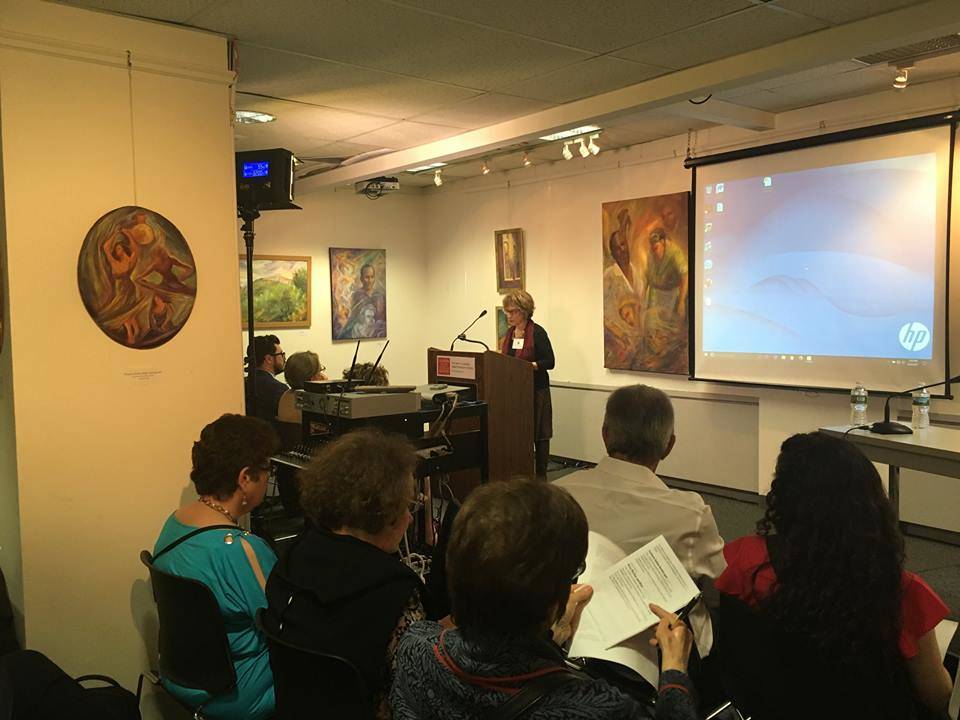Calandra Institute Explores Italian Sonorities and Acoustic Communities
This past weekend Calandra Italian American Institute hosted an exciting two-day conference called Italian Sonorities and Acoustic Communities: Listening to the Soundscapes of Italianità. The event set out to answer where we find and how we can hear the Italian acoustic communities that have existed in the historical past and that exist today—based around a transnational understanding of Italianness that encompasses the modern nation-state of Italy, including its diaspora and former colonies. Such soundscapes, for example as described in the program, can be composed of Mussolini’s rabble-rousing broadcasts from the balcony of Piazza Venezia to Frank Sinatra’s bel canto vocal styling.
Overall, the conference focused on Italian sonorities broadly defined in order to discover hitherto unexplored perspectives and expressions regarding such movements and identities. The panelists ranged from university professors and scholars to public intellectuals to performers, including singers, poets, and an organito player. A few standouts were: Donna Chirico, Calandra's campus delegate for York College, who chaired the "Women and Workers" segment and gave a lecture entitled Sounds of Silence: The Deaf and Hearing-Impaired Community as Linguistic Minority among Italians and Italian Americans; independent scholar George de Stefano, who gave the lecture, La Notte della Taranta: Musicking as a Social Act and Metaphor for Social Relationships, and chaired the "Disco, Hip Hop, and Mina" portion; and John Gennari of the University of Vermont, who kicked off the conference with his keynote address, Mediations on Italian American Soundfulness.
Anthony Julian Tamburri, Dean of Calandra, shared that the goal of the conference was in line with the goal of the institute: “to study and promote the history and culture of Italians in America.” He elaborated that this goes beyond preserving because “the expression of culture changes from one generation to the next,” referencing the “development of Italian culture outside of Italy.” He emphasized that the events were heavily centered around the expression of Italianness outside of Italy, recalling that all of their previous annual conferences have dealt with an aspect of this in some way.
Tamburri also shared that he’s drawn to the idea of sonorities because of its many facets, saying it pertains to speech, song, cinema, and language. “It also deals with temperament in some ways because the one thing I think we can say we inherited from Italy was a sense of demonstrative expressivity, and we tend to be very demonstrative when we express our sentiments or ideas and our wishes.”
He lamented that Italian is not as spoken as it used to be. However, he expressed positive sentiments in regards to the rediscovery, explaining that “3rd and 4th generation Italians are going back to learn Italian,” adding that there’s even a “rebirth of an interest in dialect,” which he described as “an expression of the heart for those who speak it all over Italy.” Another optimistic observation, he believes that with the launching of the Made in Italy in the late 70s, “a lot of things have come back to life, whether its song, cinema, and things of that sort.” He concluded on this front, “So, while we lost some stuff, I think we’ve recuperated others, and some of us are hopeful that language will continue to grow.”
Joseph Sciorra, Director for Academic and Cultural Program at Calandra, is the man responsible for coming up with the idea each year. He explained that the topic has to be “broad enough that you get a number of different people, but that’s also specific enough that it’s not too broad.”
He added, "I come up with the idea, and then I start kicking it around, talking with people--Rosangela Briscese, Sean, and Anthony in particular, and then re-write the call for papers. With something so specific as sound, I reach out to colleagues, and the colleague I reached out to was John Gennari because he writes about sound, he writes about music, and he’s also the keynote who gave a special lecture about the sound."
He expressed, “Sound is one of those things that we’re not always aware of. We’re a visual culture. Western world is normally visual and with the Internet, even more so. The idea to be sensitive and aware of how sound shapes our world, how we shape the world through sound, how sound creates a sense of identity, projects a sense of identity.” He continued, “One thinks of accents—your accent from Italy, my accent from New York, dialect sounds, the way people speak, their inflection. Those things are very much indicators of who people are and how people are viewed.” He even added that Italian Americans were historically seen as singers.
“Then the question is, what happens when sound is mediated, when it’s recorded, when it’s transmitted, when it’s put into movies, when it’s made into a podcast. Also things like oral histories, who records these, how people’s voices and sounds get documented. What do people do with them, and who has the responsibilities with those recorded sounds? All of that is sort of part of what this conference is about.”
As part of the “Tango y Los Italianos” segment, Calandra’s own Fred Gardaphé, Distinguished Professor of English and Italian American Studies, even danced. He said, "I have always been moved by music of all types: from ninna nannas to Big Band orchestras, Classical to Rock and Roll, but it was in Tango that I heard my past telling me to bring it into the present. It's that immigrant's music filled with ancestral longing for a better life while lamenting the need to leave home that caught me one day and I haven't stopped dancing since."









































i-Italy
Facebook
Google+
This work may not be reproduced, in whole or in part, without prior written permission.
Questo lavoro non può essere riprodotto, in tutto o in parte, senza permesso scritto.